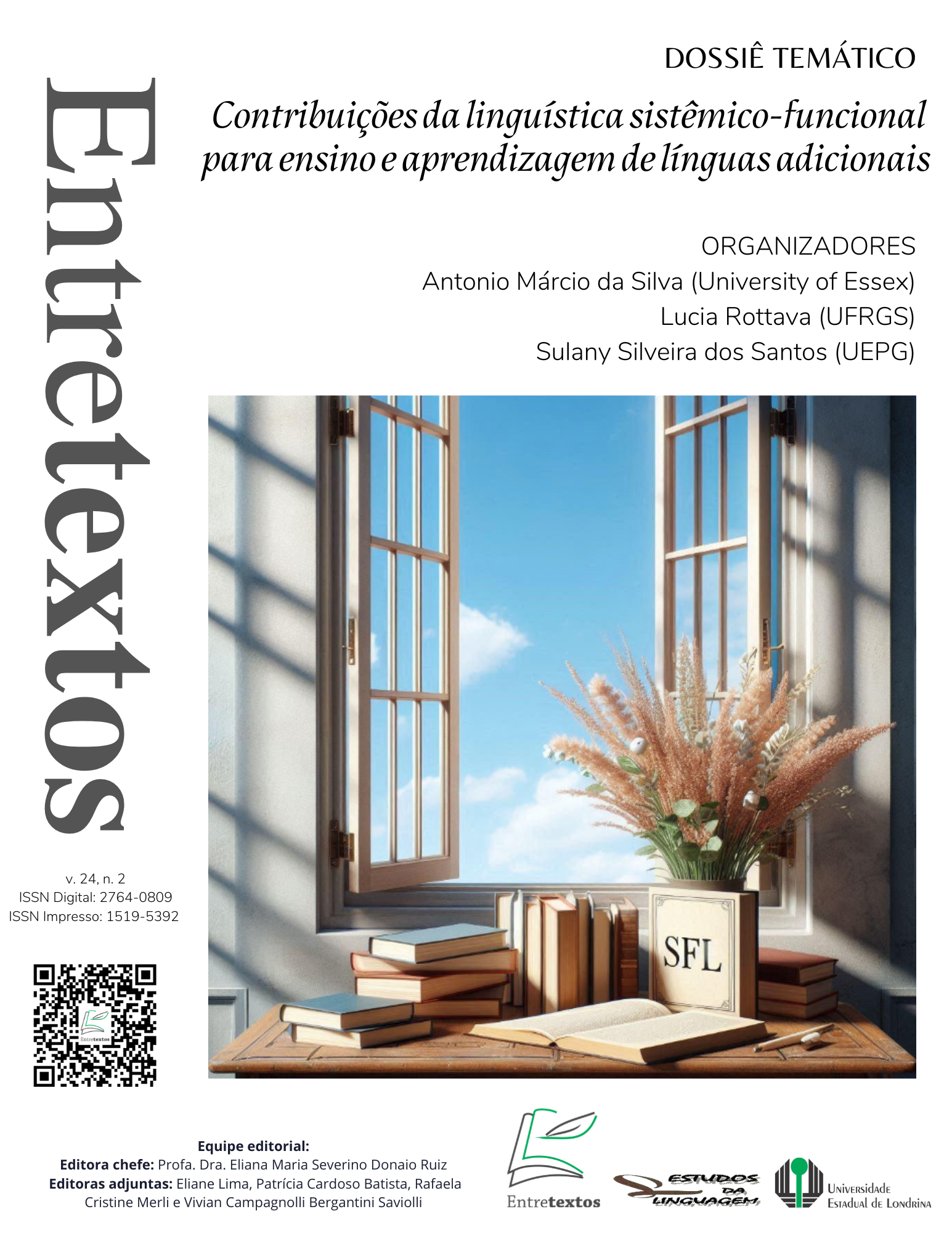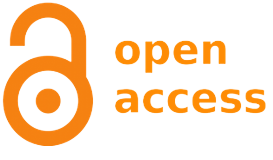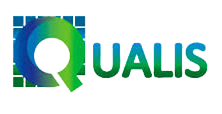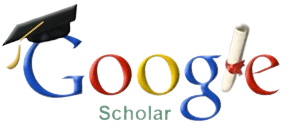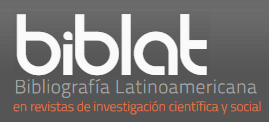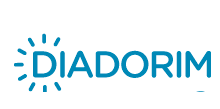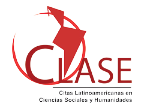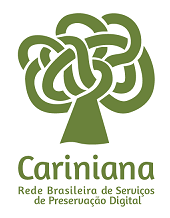Contributions of Multimodality in understanding visuality in Portuguese as L2 teaching materials for deaf
DOI:
https://doi.org/10.5433/1519-5392.2024v24n2p146-170Keywords:
Multimodality, Portuguese Teaching to Deafs, Teaching Materials, VisualityAbstract
In this article, we intend to present and comment on some partial results of ongoing research funded by CNPq (Call PQ4/ 2021), which is guided by the following questions: What would be the characteristics of teaching material for teaching Portuguese as a second language (PL2) for the deaf? How can these characteristics contribute to promoting language knowledge and its use? It is intended to show the specific treatments given to visuality in teaching materials for deaf through teaching materials prepared by Freitas (2018) and Silva and Guimarães (2018). The visuality present in these materials for deaf is approached from studies on multimodality under a social semiotic perspective, based on Kress (2010), Van Leeuwen (2005), Kress and Van Leeuwen (1996) and Kress and Van Leeuwen (2001), focusing on the concepts of representation, semiotic mode, semiotic resources, and issues linked to the Grammar of Visual Design concerning representational, interactional and compositional metafunctions. Analyzes are presented that have indicated visuality as a fundamental element for the education of deaf people, involving images (photos, drawings, graphs, and pictures), Libras in static images or videos, and writing in Portuguese. The analyses show that different images contribute to the development of PL2 content for deaf people, integrating and highlighting, methodologically, static images, videos, use of Libras, written Portuguese language, promoting representations, interactions, and textual organizations that can help in the development of the language target, respecting visuality as something fundamental in communication between and with deaf people.
Downloads
References
ALLWRIGHT, D. Six promising directions in applied linguistics. In: GIEVE, S.; MILLER, I. K. (ed.). Understanding the language classroo. Hampshire: Palgrave Macmillan, 2006. p. 11-17. DOI: https://doi.org/10.1057/9780230523166_2
ALMEIDA FILHO, J. C. P. Linguística aplicada, ensino de línguas e comunicação. Campinas: Pontes Editores, 2011.
FREITAS, L. G. A multimodalidade no ensino de língua portuguesa para alunos surdos nos anos iniciais: uma proposta de material didático. 2018. Dissertação (Mestrado em Estudos de Linguagens) – Centro Federal de Educação Tecnológica de Minas Gerais, Belo Horizonte, 2018. Disponível em: https://sig.cefetmg.br/sigaa/verArquivo?idArquivo=2097223&key=e18a2701f8b9623c7dd60d35ecaec6ee. Acesso em: 25-03-2024
HALLIDAY, M.A. K; HASAN, R. Language, context and text: aspects of language in social semiotic perspective. Oxford: Oxford University Press, 1989.
KAWASE, E. M. Revisão sistemática sobre produção de vídeos na escola para alunos surdos. Dissertação de Mestrado. São Carlos, UFSCar, 2020.
KRESS, G. Multimodality: a social semiotic approach to contemporary communication. New York: Routledge, 2010.
KRESS, G.; VAN LEEUWEN, T. Multimodal discourse: the modes and media of contemporary communjication. London: Hodder Education, 2001.
KRESS, G.; VAN LEEUWEN, T. Reading images: the grammar of visual design. New York: Routledge, 1996.
LOPES, L. P. M. (org.). Por uma linguística aplicada indisciplinar. São Paulo: Parábola Editora, 2006.
MIRANDA, D. G. A multimodalidade no ensino da língua portuguesa como segunda língua para surdos: análise do uso do livro didático adaptado em libras. 2019. Tese (Doutorado em Estudos de Linguagens) – Centro Federal de Educação Tecnológica de Minas Gerais, Belo Horizonte, 2019. Disponível em: https://sig.cefetmg.br/sigaa/verArquivo?idArquivo=2453227&key=74c14c2bf400aeb8085a14fdda5e9a08. Acesso em: 25 mar. 2024.
PAIVA, V. L. M. O. Aquisição de segunda língua. São Paulo: Parábola Editora, 2014.
PEREIRA, F. M. Surdez e Tecnologias de Informação e Comunicação. IN.; SILVA, I. R.; KAUCHAKJE, S.; GESUELI, Z.M. (org.). Cidadania, Sudez e Linguagem: desafios e realidades. 4ª ed. São Paulo: Plexus Editora, 2003, p. 193-217.
PEREIRA, M. C. C.; CHOI, D.; VIEIRA, M. I.; GASPAR, P.; NAKASATO, R. Libras: conhecimento além dos sinais. São Paulo: Pearson Prentice Hall, 2011.
QUADROS, R. M. Educação de surdos: a aquisição da linguagem. Porto Alegre: Artmed, 2008.
QUADROS, R. M; SCHMIEDT, M. L. P. Ideias para ensinar português para alunos surdos. Brasília, DF: MEC; SEESP, 2006.
REILY, L. As imagens: o lúdico e o absurdo no ensino de arte para pré-escolares surdos. In: SILVA, I. R.; KAUCHAKJE, S.; GESUELI, Z. M. (org.). Cidadania, surdez e linguagem: desafios e realidades. 4. ed. São Paulo: Plexus Editora, 2003. p. 161-192.
SILVA, R. C. Contribuições da visão sociossemiótica da linguagem e da multimodalidade como apoio à educação linguística de surdos. In: MIRANDA, D. G.; FREITAS, L. Educação para surdos: possibilidades e desafios. Belo Horizonte: Mazza Edições, 2019. p. 61-74.
SILVA, R. C. Implicações de se assumir a multimodalidade nos estudos de linguagem. In: SILVA, R. C.; QUEIRÓZ, L. A. A. Multimodalidade e discursos. São Paulo: Pimenta Cultural, 2021. p. 26-53. DOI: https://doi.org/10.31560/pimentacultural/2021.363.26-53
SILVA, G. M. da. GUIMARÃES, A. B. C. Português para crianças surdas: leitura e escrita no cotidiano. Belo Horizonte: UFMG, 2018. Disponivel em: chrome-extension://efaidnbmnnnibpcajpcglclefindmkaj/http://www.letras.ufmg.br/padrao_cms/documentos/eventos/portuguesl2surdos/PORTUGUES%20PARA%20CRIAN%C3%87AS%20SURDAS_ALUNO.pdf. Acesso em: 25 mar. 2024.
VAN LEEUWEN, T. Introducing social semiotics. New York: Routledge, 2005. DOI: https://doi.org/10.4324/9780203647028
Downloads
Published
How to Cite
Issue
Section
License
Copyright (c) 2024 Renato Caixeta da Silva Silva

This work is licensed under a Creative Commons Attribution 4.0 International License.
Entretextos adota a Licença Creative Commons Attribution 4.0 International, portanto, os direitos autorais relativos aos artigos publicados são do(s) autor (es).
Sob essa licença é possível: Compartilhar - copiar e redistribuir o material em qualquer suporte ou formato. Adaptar - remixar, transformar, e criar a partir do material, atribuindo o devido crédito e prover um link para a licença e indicar se mudanças foram feitas.
Funding data
-
Conselho Nacional de Desenvolvimento Científico e Tecnológico
Grant numbers 316840/2021-1

